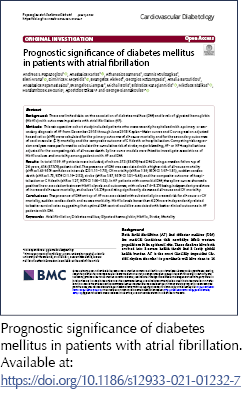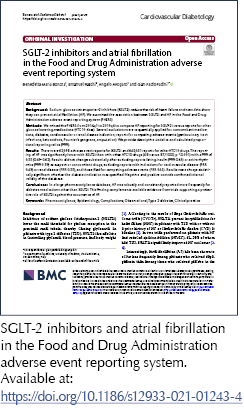Atrial fibrillation (AF) is the most common sustained cardiac arrhythmia, with a lifetime risk of around 25% in those over 40 years of age (Lloyd-Jones et al, 2004). People with diabetes have a roughly 40% greater risk of developing AF than those without diabetes (Huxley et al, 2011). AF is an independent risk factor for stroke and heart failure, and is associated with more severe strokes due to the large clots that embolise from the heart (Lin et al, 1996; Berg et al, 2019).
A recent study by Papazoglou et al (2021) has highlighted the increased risk associated with comorbid diabetes in people with AF. In a substudy of the MISOAC-AF (Motivational Interviewing to Support Oral AntiCoagulation Adherence in patients with non-valvular AF) trial, 1140 people with AF, of whom a third had diabetes, were followed for a median of 2.6 years. Over that time frame, 36% of the cohort died, mostly from cardiovascular causes. In particular, people with diabetes were significantly more likely to die from cardiovascular causes than those without the condition (34.9% vs 23.5%; P<0.001). After adjustment for other risk factors, diabetes remained a significant predictor of adverse outcomes, increasing the risk of all-cause death by 44%, cardiovascular death by 44%, cardiac arrest by 73% and stroke by 87%. Glycaemic control significantly affected mortality, with each 11 mmol/mol (1.0%) increase almost doubling the risk of all-cause and cardiovascular mortality, and a linear association between HbA1c and death. The risk of death was significantly lower at HbA1c levels under 44 mmol/mol (6.2%). Other factors associated with survival were age; estimated glomerular filtration rate; and use of beta-blockers, digoxin, angiotensin-converting enzyme inhibitors, angiotensin receptor blockers and novel oral anticoagulants after discharge.
These findings concur with those of other AF studies, which showed a nearly doubled risk of mortality in people with AF and comorbid diabetes compared to those without diabetes. The results highlight the high personal costs associated with AF, particularly in those with diabetes, and emphasise the urgent need to manage both glycaemia and other cardiovascular risk factors in people who develop AF.
A role for SGLT2 inhibitors?
Another study, published in the same issue of Cardiovascular Diabetology, provides evidence that sodium–glucose cotransporter 2 (SGLT2) inhibitors may be effective in preventing new-onset AF in people with type 2 diabetes. Using a data-mining approach, Bonora et al (2021) searched the US Food and Drug Administration’s adverse event reporting system to compare rates of AF between SGLT2 inhibitors and other glucose-lowering drugs. Between 2014 and the end of 2019, there were 62098 adverse events in which an SGLT2 inhibitor was suspect or concomitant, compared with 642031 reports involving other glucose-lowering drugs.
The reporting of AF was significantly lower with SGLT2 inhibitors than with other diabetes drugs (4.8 versus 8.7 events per 1000 reports; P<0.001), implying a potential protective effect. The results were consistent when a number of sensitivity analyses were carried out to exclude effects of other treatments, diabetes severity, kidney disease and cardiovascular disease as treatment indications, and dilution by other SGLT2 inhibitor adverse events such as urinary tract infections and diabetic ketoacidosis. These real-world findings support the results from clinical and cardiovascular outcome trials and observational studies suggesting that SGLT2 inhibitors can prevent AF in people with type 2 diabetes (Li et al, 2020; Ling et al, 2020; Zelniker et al, 2020; Okunrintemi et al, 2021). The authors have previously proposed a number of mechanisms by which SGLT2 inhibitors might reduce the risk of AF (Bonora et al, 2020), many of which may also explain the drug class’s known effects on reducing heart failure.
Conclusion
The precise reasons for the association between AF and diabetes remain unexplained. However, it is encouraging that a widely used glucose-lowering drug class can potentially reduce the burden of this common diabetes comorbidity. Above all, these studies remind us of the need to consider the cardiovascular aspects of diabetes management.






Study provides new clues to why this condition is more aggressive in young children.
14 Nov 2025